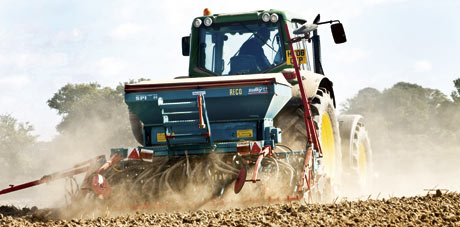Dry seed-beds cause drilling and agronomy rethink

Dry seed-beds across the east of the country are raising questions over drilling strategies and pre-emergence herbicide applications.
Parts of the south-east, East Anglia and Lincolnshire have been dry for more than 30 days. “The further east you go, the drier it is. It’s an issue for everyone east of the Pennines,” says Dave Robinson of The Arable Group.
Even in the north, seedbeds are very dry on top, he reports. “Where they’ve been consolidated effectively, they’ve drawn up moisture and drilling is taking place in reasonable conditions.”

Cobbly seedbeds are all too common in the east this year, and some growers are being advised to delay drilling until there is more moisture.
Both patchy emergence and blue mould are potential problems with cereals in parched ground, he warns. “No one likes to sit on their hands at this time of year, but if you’ve got cobbly seed-beds, it would be wise to wait.”
David Ellerton of ProCam agrees. “Drilling into very poor, dry seedbeds is counterproductive. We are already seeing some blue mould on seed which has been sitting around, making seed treatments a necessity.”
Cereal crops which were drilled deeper than usual found some moisture and seem to be coming through well, he notes.
Pre-emergence herbicides should be applied, both men agree. “They will sit there until activated by rain,” says Dr Ellerton. “It’s better to get them on in the dry than not at all.”
But he stresses that conditions are not ideal. “Some moisture is required for best results. Fortunately, most pre-emergence herbicides are photo-stable, so they don’t break down rapidly like trifluralin did.”
Growers with cobbly seedbeds or shallow-drilled crops, who don’t want to risk an application, should obtain their pre-emergence choices, advises Dr Ellerton. “Be ready to go when you get some rain. Serious grassweeds aren’t worth the risk.”
Independent Somerset agronomist Stephen Harrison reports a clear distinction between seed-beds created with non-inversion tillage and those prepared with the plough.
“Land that was ploughed and left is so dry it’s unworkable,” he says. “In contrast, seed-beds from non-ploughing regimes are fine and the wheat seed is chitting within three days.”
Dry soils
|
|---|
He also believes that growers should go ahead with planned flufenacet-based pre-emergence herbicides. “It’s only those with very poor seed-beds who should hold fire.”
However, if the next couple of weeks remain dry, the situation is less clear, he warns. “We’ll be in unknown territory. All herbicides degenerate over time and there won’t be any grassweed germination without some rain.”
Agrovista agronomist Rob Hughes in Shropshire also reports very dry, powdery soils. “Drilling is taking place if land can be broken down. Soil temperatures are holding up, so cereals drilled a bit deeper than usual are coming up quickly.”
Residual herbicides should ideally be applied on to moist soils, he advises. “Growers with big acreages are having to apply them, even where conditions aren’t ideal. It’s a management decision.”
In Scotland, seed-beds are mostly very good, says Allen Scobie of Bridgend Partners. “We had so much wet weather a few weeks ago that cereal seedbeds are looking the best they’ve done for a while.”
Temperatures are also holding up so both sowing and herbicide applications are taking place as expected, he comments.
David Waite of Frontier Agriculture is of the same opinion. “After the heavy rain in the first week of September, the soil is fairly wet and drilling is taking place. But there are concerns about dry conditions in Yorkshire and Lincolnshire.”

